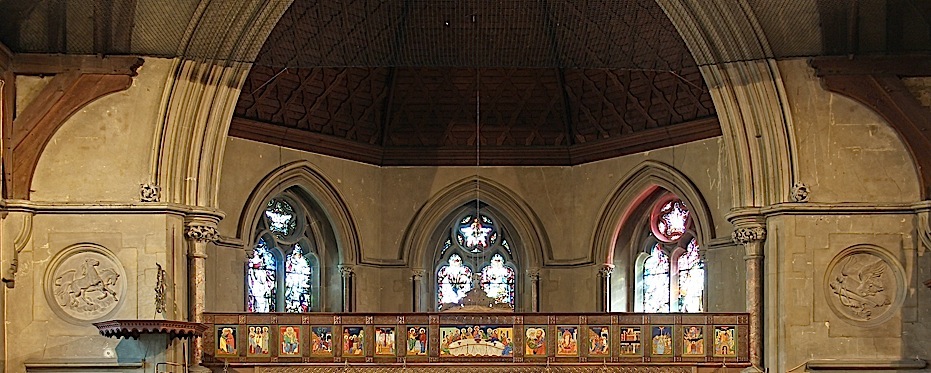Photographs by John Salmon and text by Jacqueline Banerjee, 2016. You may use these images without prior permission for any scholarly or educational purpose as long as you (1) credit the photographer and (2) link your document to this URL. Click on the images to enlarge them.

The interior of the church, looking east.
The former Agapemonite Church of the Ark of the Covenant, on Rookwood Road in Upper Clapton, London, became for several decades (from 1956-2007) the Ancient Catholic Cathedral Church of the Good Shepherd, and is now the Georgian Orthodox Cathedral Church of the Nativity of Our Lord. However, the building designed by Joseph Morris & Sons in the early 1890s has not changed, and much of the interior remains as it was at the end of the Victorian period. Built to seat about 400 people (see Baker), it was an expensive project: the listing text puts the cost at "some £15,000." Notice the fine hammer-beam roof, and the carved corbels along the aisleless nave, in the photograph above.

Looking into the apse.
The The present church's iconostatis unfortunately hides the mosaic-work in the apse, and obscures the stained glass there, but on either side of the chancel arch can be seen roundels, with reliefs carved by A. G. Walker. The one on the left shows Elijah in his chariot, and the one on the right shows the scroll of Enoch (these echo the roundels above the west window outside). The importance of Elijah and Enoch for the sect lies in the belief that they were taken up into heaven without dying.



Left to right: (a) Roundel showing the winged scroll of Enoch, on the right of the arch. (b) The original Father Willis organ on this side, with a corbel to the far right carved with a representation of St Mark, as a lion. (c) The carved nave benches.
Like the lectern and pulpit, the benches are the original ones. They have unusual open-work ends, and may have been designed and even worked by Morris's daughter Olive. There is a glimpse here of the magnificently rich stained-glass windows along the nave. Dating from 1896, these were designed by Walter Crane. These were the main reason for Sir John Betjeman's delight on visiting Agapemonites' former church: "the inside of their church at Clapton is a blaze of glory," he exclaimed.




Corbels carved with representations of (left to right) (a) St Matthew, as a winged man. (b) St Mark, as a winged lion. (c) St Luke, as an ox. (d) St John as an eagle.
As in the large figures on the exterior stonework, each of these surmounts a smaller human figure representing the suffering of life which is to be overcome. In this way The iconographic scheme is integral to the building both inside and out, making a consistent fully harmonised statement of the Agapemonites' faith.

Looking west towards the beautiful west windows and the west screen, which also has Crane's brilliant stained glass in the openwork.

Another view of St Matthew, and the weeping figure beneath him.
Related material
- Exterior of the church
- A selection of closer views
- Walter Crane's windows (including those in the apse) and the stained glass designs for the west screen
- The Agapemonite sect
Bibliography
Baker, T. F. T., ed. "Hackney: Protestant Nonconformity." A History of the County of Middlesex: Volume 10, Hackney. London, 1995: 130-144. British History Online. Web. 12 October 2016.
Betjeman, John. "City and Suburban." The Spectator Archives. 3 February 1956, p. 12. Web. 12 October 2016. Cherry, Bridget, and Nikolaus Pevsner. London 4: North. New Haven and London: Yale University Press, 2002. "The Former Ark of the Covenant." Historic England. Web. 12 October 2016. Created 12 October 2016